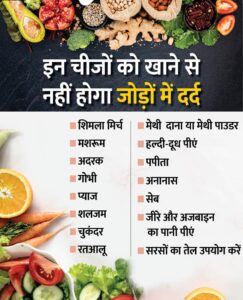
I can provide a general diet chart that may help individuals with joint pain. However, it’s important to note that consulting with a healthcare professional or a registered dietitian is essential to tailor a diet plan specifically to an individual’s needs and condition. A diet can be a part of a holistic approach to managing joint pain, but it’s not a substitute for medical treatment.
Here’s a sample diet chart for joint pain:
Breakfast:
- Oats with Berries and Nuts:
- Cooked oats topped with a handful of mixed berries (e.g., blueberries, strawberries) and a few nuts (e.g., walnuts, almonds). Berries are rich in antioxidants and oats provide fiber.
- Greek Yogurt Parfait:
- Greek yogurt layered with chopped fruits (e.g., banana, apple) and a sprinkle of chia seeds. Greek yogurt is a good source of protein and calcium.
Mid-Morning Snack:
- A Piece of Fruit:
- Choose a piece of fruit such as an orange, apple, or a banana for a nutritious snack.
Lunch:
- Grilled Salmon Salad:
- Grilled salmon on a bed of mixed greens (e.g., spinach, kale) with colorful vegetables (e.g., bell peppers, tomatoes) and a light vinaigrette dressing. Salmon is rich in omega-3 fatty acids, which may help reduce inflammation.
- Quinoa and Vegetable Bowl:
- Cooked quinoa with a variety of steamed or roasted vegetables (e.g., broccoli, carrots, zucchini). Quinoa provides protein and fiber.
Afternoon Snack:
- Mixed Nuts:
- A small handful of mixed nuts like almonds, walnuts, and cashews. Nuts provide healthy fats and protein.
Dinner:
- Baked Chicken with Steamed Vegetables:
- Baked chicken breast with a side of steamed vegetables (e.g., broccoli, asparagus, spinach). Chicken is a good source of lean protein.
- Lentil Soup:
- Lentil soup with a side of whole-grain bread or a small portion of brown rice. Lentils are rich in protein and fiber.
Evening Snack:
- Yogurt with Honey:
- Plain yogurt drizzled with a little honey. Yogurt provides calcium and protein.
General Tips:
- Hydration:
- Drink plenty of water throughout the day to stay hydrated and maintain joint health.
- Anti-Inflammatory Foods:
- Include foods that are known for their anti-inflammatory properties, such as turmeric, ginger, and green tea.
- Omega-3 Fatty Acids:
- Incorporate sources of omega-3 fatty acids like fatty fish (e.g., salmon, mackerel), flaxseeds, and chia seeds.
- Limit Processed Foods:
- Reduce consumption of processed foods, sugary snacks, and drinks, as they may contribute to inflammation.
It’s crucial to work with a healthcare professional to determine the best approach for managing joint pain through diet and lifestyle changes.


